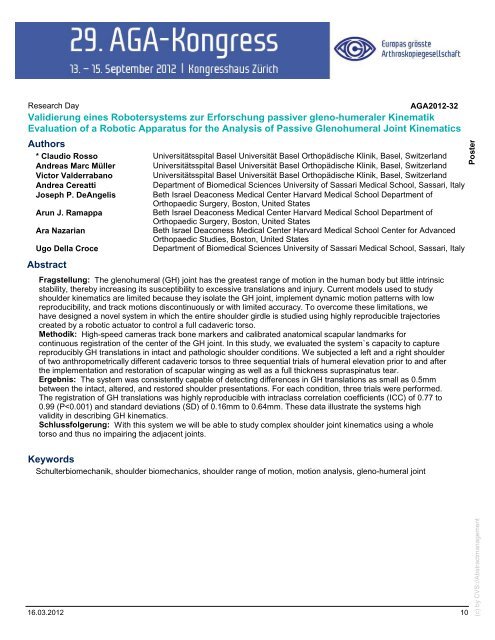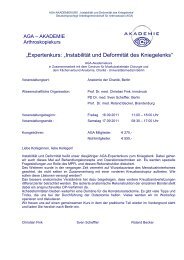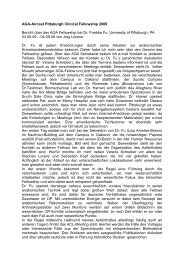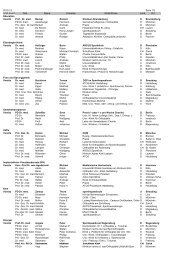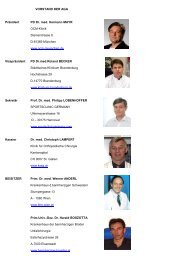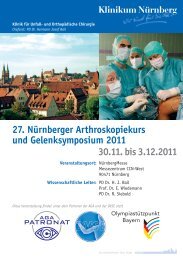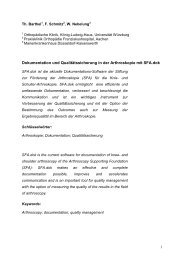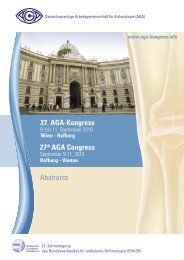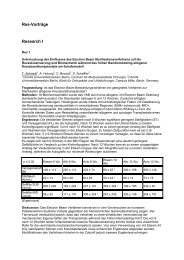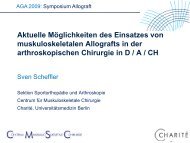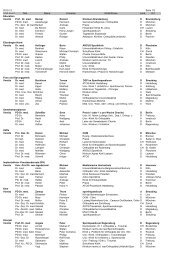- Seite 1 und 2: Basisdaten Deadline Einreichung 16.
- Seite 3 und 4: Knie AGA2012-22 Aussagekraft der MR
- Seite 5 und 6: Knie Kontrolle der Teilbelastung mi
- Seite 7 und 8: Knie ALL INSIDE ST-VKB PLASTIK MIT
- Seite 9: Research Day AGA2012-31 The Role of
- Seite 13 und 14: Sprunggelenk Die endoskopische Kalk
- Seite 15 und 16: Ellenbogen, Hand AGA2012-40 Erste E
- Seite 17 und 18: Schulter AGA2012-44 Arthroskopische
- Seite 19 und 20: Schulter AGA2012-46 Einzeitige arth
- Seite 21 und 22: Knorpeldefekt 16.03.2012 21 (c) by
- Seite 23 und 24: Hüfte AMIC bei acetabulärem Knorp
- Seite 25 und 26: ACT Knorpelschäden nicht nur repar
- Seite 27 und 28: Hysteresis (Nmm) Results 75.1±20.3
- Seite 29 und 30: Research Day AGA2012-54 Computer Na
- Seite 31 und 32: Knie AGA2012-58 Systematisches Revi
- Seite 33 und 34: Keywords vorderer Kreuzbandersatz,
- Seite 35 und 36: Schulter AGA2012-61 Ist die Stabili
- Seite 37 und 38: Knie AGA2012-63 Welchen Erkenntnisg
- Seite 39 und 40: Schulter AGA2012-64 Die Akromionmor
- Seite 41 und 42: Schulter AGA2012-68 Funktioneller O
- Seite 43 und 44: Keywords Rotatorenmanschette 16.03.
- Seite 45 und 46: Sehne Nahtmaterial Anker Rotatorenm
- Seite 47 und 48: Knie AGA2012-73 Klinische und MR-to
- Seite 49 und 50: Schulter Regeneration der Propiozep
- Seite 51 und 52: Frühfunktionell, CPM, sofortige Vo
- Seite 53 und 54: Schulter Die arthroskopische Therap
- Seite 55 und 56: Knie AGA2012-81 Anatomic ACL rekons
- Seite 57 und 58: Knie AGA2012-85 Inzidenz von Knorpe
- Seite 59 und 60: Research Day AGA2012-90 Gezüchtete
- Seite 61 und 62:
16.03.2012 61 (c) by CVS://Abstract
- Seite 63 und 64:
Knie AGA2012-93 Tissue engineering
- Seite 65 und 66:
Knie AGA2012-95 Intraartikuläres A
- Seite 67 und 68:
Knie Komplikationen der Doppelbünd
- Seite 69 und 70:
Knie AGA2012-101 Prospektive Ergebn
- Seite 71 und 72:
Schulter AGA2012-104 Computertomogr
- Seite 73 und 74:
Keywords SPECT/CT - mechanische Ach
- Seite 75 und 76:
Keywords patella, dislocation, tibi
- Seite 77 und 78:
Knie AGA2012-108 Klinische Relevanz
- Seite 79 und 80:
Schulter AGA2012-110 Arthroskopisch
- Seite 81 und 82:
Schulter AGA2012-112 Arthroskopisch
- Seite 83 und 84:
Schulter AGA2012-114 Komplexe Labru
- Seite 85 und 86:
Schulter AGA2012-116 Arthroskopisch
- Seite 87 und 88:
Knie AGA2012-118 MPFL-Rekonstruktio
- Seite 89 und 90:
Knie AGA2012-120 Standardisierte Te
- Seite 91 und 92:
Knie Reliabilität der Klassifikati
- Seite 93 und 94:
Keywords Mediale Gonarthrose, uniko
- Seite 95 und 96:
Schulter AGA2012-127 Kann die SLAP-
- Seite 97 und 98:
WOMAC Pain, Function, and Stiffness
- Seite 99 und 100:
Keywords Latarjet Schulterinstabili
- Seite 101 und 102:
Research Day AGA2012-135 Evaluation
- Seite 103 und 104:
Knie AGA2012-138 Vergleich der Bohr
- Seite 105 und 106:
Schulter AGA2012-140 MR-Assessment
- Seite 107 und 108:
Schulter AGA2012-141 Prädiktiver W
- Seite 109 und 110:
Knie AGA2012-143 Sind navigierte un
- Seite 111 und 112:
Knie AGA2012-144 3-Jahres Ergebniss
- Seite 113 und 114:
Schulter Rezidivschulterinstabilit
- Seite 115 und 116:
Schulter AGA2012-147 Rational für
- Seite 117 und 118:
Schulter AGA2012-148 Die Prävalenz
- Seite 119 und 120:
Knie AGA2012-149 Vergleich der dyna
- Seite 121 und 122:
Schulter AGA2012-152 Dislozierte Pr
- Seite 123 und 124:
Knie REGENERATION OF SEMITENDINOSUS
- Seite 125 und 126:
addressed. Keywords BMP-2, Bone mor
- Seite 127 und 128:
Schulter AGA2012-159 Arthroskopisch
- Seite 129 und 130:
Präoperativer MRT-Befund Ergebnis:
- Seite 131 und 132:
Schulter 5-Jahres-Outcome nach arth
- Seite 133 und 134:
Schulter AGA2012-168 Arthroskopisch
- Seite 135 und 136:
Research Day AGA2012-170 Gesundheit
- Seite 137 und 138:
Research Day Die simulierte ACT unt
- Seite 139 und 140:
Research Day AGA2012-174 Biomechani
- Seite 141:
Knie AGA2012-175 Biomechanische Unt
- Seite 144 und 145:
Knie Evaluation eines neuartigen Si
- Seite 146 und 147:
Knie AGA2012-180 Anatomische Refixa
- Seite 148 und 149:
Research Day AGA2012-183 Neurovasku
- Seite 150 und 151:
Knie AGA2012-185 PATIENTEN INDIKATI
- Seite 152 und 153:
Knie AGA2012-186 Rekonstruktion der
- Seite 154 und 155:
Research Day AGA2012-189 Femorale F
- Seite 156 und 157:
Knie AGA2012-190 Das intraartikulä
- Seite 158 und 159:
Knie AGA2012-192 Anatomische MPFL-
- Seite 160 und 161:
Hüfte AGA2012-194 Osteochondromato
- Seite 162 und 163:
Knie AGA2012-197 Eine neue Therapie
- Seite 164 und 165:
Knie AGA2012-198 Bovine Xenograft I
- Seite 166 und 167:
Hüfte AGA2012-200 Die Lernkurve be
- Seite 168 und 169:
Knie AGA2012-203 Rückkehr zum Spor
- Seite 170 und 171:
Research Day AGA2012-205 Der Einflu
- Seite 172 und 173:
Knie AGA2012-207 Ist die Arthroskop
- Seite 174 und 175:
Schulter 5-Jahresergebnisse nach ar
- Seite 176 und 177:
Knie Pitfalls in der MRT-Diagnostik
- Seite 178 und 179:
Schulter AGA2012-214 Einfluss der s
- Seite 180 und 181:
Hüfte AGA2012-215 Versorgungsstrat
- Seite 182 und 183:
Schulter AGA2012-217 Clinical Outco
- Seite 184 und 185:
Research Day AGA2012-219 Einfluss d
- Seite 186 und 187:
Hüfte AGA2012-220 Arthroskopische,
- Seite 188 und 189:
Research Day AGA2012-222 Einfluss v
- Seite 190 und 191:
Knie AGA2012-223 Klinische Ergebnis
- Seite 192 und 193:
Research Day AGA2012-224 Untersuchu
- Seite 194 und 195:
Keywords Schulterstabilisierung, Ar
- Seite 196 und 197:
Knie AGA2012-229 Autologes konditio
- Seite 198 und 199:
Sprunggelenk AGA2012-231 Behandlung
- Seite 200 und 201:
Research Day AGA2012-236 Aspiration
- Seite 202 und 203:
Research Day Migration von humanen
- Seite 204 und 205:
Sprunggelenk AGA2012-240 Neue endos
- Seite 206 und 207:
Keywords osteochondral konstrukt mi
- Seite 208 und 209:
Keywords MACT, MRT, Knorpel, dGEMRI
- Seite 210 und 211:
MACT, MRT, Knorpel, dGEMRIC 16.03.2
- Seite 212 und 213:
Keywords MPFL Ersatz, femoro-patell
- Seite 214 und 215:
Knie AGA2012-246 Knochendefektrekon
- Seite 216 und 217:
Ellenbogen, Hand Ein Prüfstand zur
- Seite 218 und 219:
Schulter AGA2012-249 Klinische und
- Seite 220 und 221:
Knie Kompensationsmechanismen in Kn
- Seite 222 und 223:
Hüfte AGA2012-251 Geschlechtsspezi
- Seite 224 und 225:
Knie AGA2012-253 ANATOMISCHE einzig
- Seite 226 und 227:
Knie iBalance 4 Jahre follow-up und
- Seite 228 und 229:
Knie Kniegelenksfunktion 20 Jahre n
- Seite 230 und 231:
Knie AGA2012-258 2 Jahres-Ergebniss
- Seite 232 und 233:
Kujala/IKDC (prae-und postoperativ)
- Seite 234 und 235:
Knie AGA2012-260 GRENZEN DER ARTROS
- Seite 236 und 237:
Research Day AGA2012-262 Grüntee P
- Seite 238 und 239:
Research Day AGA2012-263 Zweijahres
- Seite 240 und 241:
Knie AGA2012-264 Heilung der Vorder
- Seite 242 und 243:
Schulter AGA2012-270 Radiologische
- Seite 244 und 245:
Schulter AGA2012-272 Ergebnisse der
- Seite 246 und 247:
Ellenbogen, Hand AGA2012-273 Die an
- Seite 248 und 249:
Knie AGA2012-275 Fremdmaterialfreie
- Seite 250 und 251:
p=0,95), der Abd-Add (p=0,06 und p=
- Seite 252 und 253:
Schulter AGA2012-277 Klinische Erge
- Seite 254 und 255:
Knie AGA2012-280 Tibiale isolierte
- Seite 256 und 257:
Knie AGA2012-282 Refixation der Inn
- Seite 258 und 259:
Hüfte Azetabuläre Labrumläsionen
- Seite 260 und 261:
Hüfte AGA2012-287 Radiologische Pr
- Seite 262 und 263:
Knie AGA2012-289 Der Einfluss von I
- Seite 264 und 265:
Sprunggelenk AGA2012-290 Das Pseudo
- Seite 266 und 267:
Knie AGA2012-292 Prospektive Verlau
- Seite 268 und 269:
Schulter AGA2012-294 Der Latissimus
- Seite 270 und 271:
Schulter AGA2012-296 Vergleich der
- Seite 272 und 273:
Schulter AGA2012-298 Aseptische Ost
- Seite 274 und 275:
Schulter Arthroskopische Therapie d
- Seite 276 und 277:
Hüfte Gelenkerhaltende Therapie be
- Seite 278 und 279:
Bobrowitsch, Evgenij AGA2012-127 Bo
- Seite 280 und 281:
Gosheger, Georg AGA2012-64 Grad, Si
- Seite 282 und 283:
Kohn, Ludwig AGA2012-297 Kölblinge
- Seite 284 und 285:
Nikolic, Nikola AGA2012-107 Nitsche
- Seite 286 und 287:
Seitlinger, Gerd AGA2012-221 Seitz,


